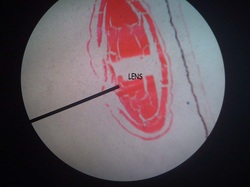
The lens consists of a lens capsule, the subcapsular epithelium and lens fibres. It does not contain blood vessels or nerves.
The lens capsule is generated by the cells of the subcapsular epithelium and corresponds to a thick, elastic basal lamina. The zonule fibres insert into the lens capsule.
Cells of the subcapsular epithelium (or anterior lens cells) are mitotically active. In adult individuals they only cover the anterior "hemisphere" of the lens. As they divide, cells gradually move towards the equator of the lens where they tranform into lens fibres. The apical part of the gradually elongating cell extends between the subcapsular epithelium and adjacent lens fibres towards the anterior pole of the lens. The basal part extends towards the posterior pole. The nucleus remains close to the equatorial plane of the lens.
The mature lens fibres, i.e. very long (up to 12 mm), hexagonal cells, form the body of the lens. They are located immediately deep to the cells of the subcapsular epithelium. Lens fibres are nucleated in the soft, outer cortex of the lens. As new lens fibres are added to the periphery of the cortex, lens fibres located deeper in the cortex loose their nuclei and become part of the somewhat harder nucleus of the lens. In the intact lens, lens fibres are tightly connected to each other. Few organelles are scattered in a cytoplasm filled withcystallin proteins. These proteins are responsible for the transparency and refractive properties of the lens and account for up to 60% of the mass of lens fibres.
Reference: www.lab.anhb.uwa.edu.au
The lens capsule is generated by the cells of the subcapsular epithelium and corresponds to a thick, elastic basal lamina. The zonule fibres insert into the lens capsule.
Cells of the subcapsular epithelium (or anterior lens cells) are mitotically active. In adult individuals they only cover the anterior "hemisphere" of the lens. As they divide, cells gradually move towards the equator of the lens where they tranform into lens fibres. The apical part of the gradually elongating cell extends between the subcapsular epithelium and adjacent lens fibres towards the anterior pole of the lens. The basal part extends towards the posterior pole. The nucleus remains close to the equatorial plane of the lens.
The mature lens fibres, i.e. very long (up to 12 mm), hexagonal cells, form the body of the lens. They are located immediately deep to the cells of the subcapsular epithelium. Lens fibres are nucleated in the soft, outer cortex of the lens. As new lens fibres are added to the periphery of the cortex, lens fibres located deeper in the cortex loose their nuclei and become part of the somewhat harder nucleus of the lens. In the intact lens, lens fibres are tightly connected to each other. Few organelles are scattered in a cytoplasm filled withcystallin proteins. These proteins are responsible for the transparency and refractive properties of the lens and account for up to 60% of the mass of lens fibres.
Reference: www.lab.anhb.uwa.edu.au